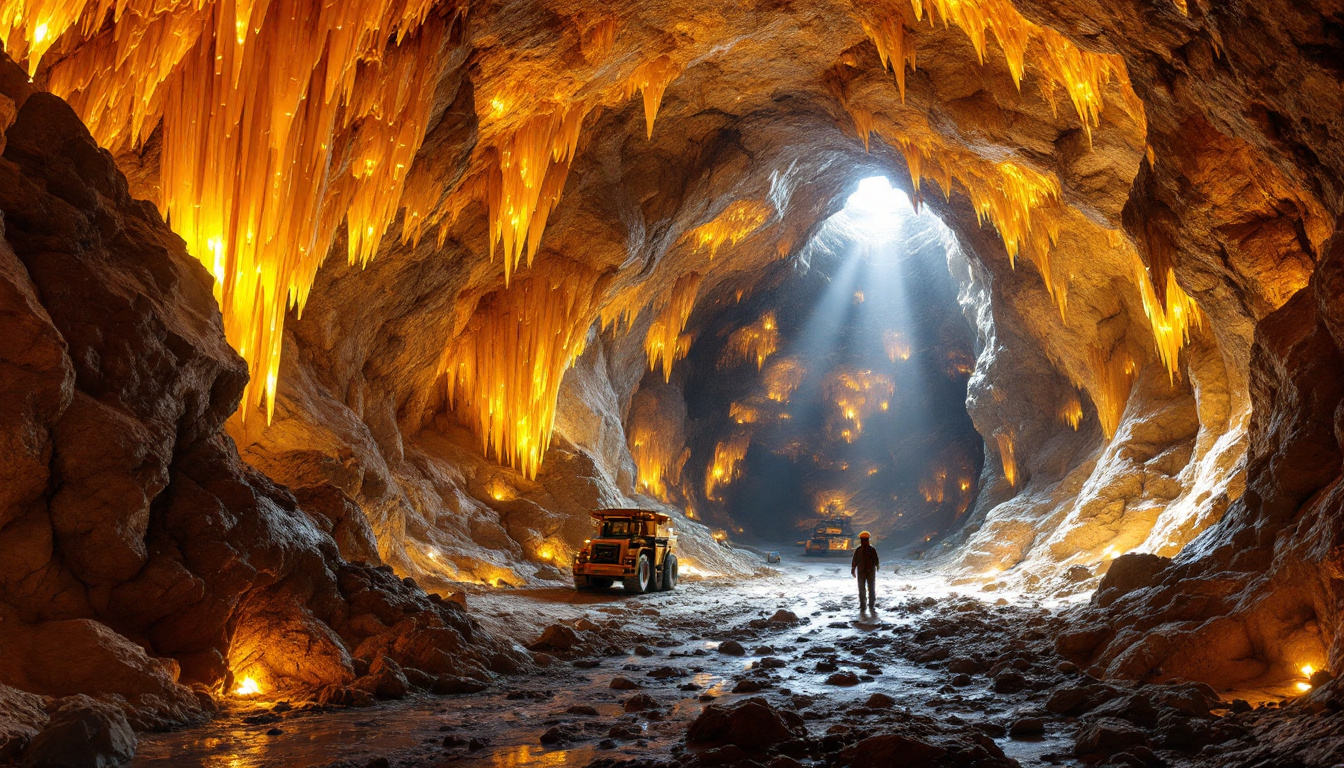Understanding Uranium Stocks in Today's Market
Uranium stocks represent shares in companies involved in the exploration, mining, processing, and trading of uranium – the key fuel for nuclear reactors worldwide. These investments have gained significant attention in recent years, driven by a complex interplay of geopolitical tensions, energy security concerns, and the growing recognition of nuclear power's role in achieving carbon reduction goals. The Russian uranium export ban has further complicated the supply dynamics. The uranium stocks market experienced a remarkable bull run in late 2023 and early 2024, with prices reaching 15-year highs before undergoing a correction in 2025.
The market fundamentals remain compelling despite this recent volatility. Current estimates indicate a 20 million pound supply deficit, which analysts project will expand to 25 million pounds by 2030. Meanwhile, mine supply is expected to grow by approximately 50 million pounds during this period, highlighting the significant gap between production capabilities and anticipated demand.
What makes uranium particularly interesting as an investment is its unique position at the intersection of energy security and climate policy. Unlike other commodities, uranium benefits from both traditional baseload power requirements and emerging clean energy mandates, creating a relatively stable long-term demand profile despite short-term price fluctuations.
What Are Uranium Stocks and Why Are They Important?
The Fundamentals of Uranium as an Investment
Uranium stands apart from other commodities due to its irreplaceable role in nuclear power generation. While alternatives exist for most energy sources, nuclear power's unique combination of reliability, energy density, and zero-carbon operation creates a distinct investment thesis. Uranium is essentially non-substitutable in its primary application, meaning demand remains relatively inelastic despite price changes.
The uranium investment landscape encompasses companies across the entire nuclear fuel cycle – from junior explorers to major producers, enrichment facilities, and even utilities with significant nuclear fleets. The sector's cyclicality stems primarily from long lead times between investment decisions and production, creating periodic supply-demand imbalances that can dramatically affect prices.
Uranium stocks typically exhibit higher volatility than the broader market, with beta values between 1.5-2.0, reflecting their sensitivity to both commodity prices and policy shifts. This volatility creates both significant risks and strategic uranium investments opportunities for investors with appropriate time horizons.
Key Applications Driving Uranium Demand
While nuclear power generation remains uranium's primary application, consuming approximately 95% of global production, several other specialized uses contribute to its overall demand profile. These include:
- Medical isotope production for cancer treatments and diagnostic procedures
- Research reactors for scientific advancement and isotope development
- Nuclear-powered naval vessels, particularly submarines and aircraft carriers
- Space exploration, where radioisotope thermoelectric generators power missions to distant planets
The emerging factor increasingly driving uranium demand is the explosive growth of artificial intelligence and data centers. Industry projections suggest AI and data center operations could increase global energy demand by 15% by 2030, creating substantial new electricity requirements that must be met through reliable, baseload power sources like nuclear energy.
The Role of Nuclear Power in the Energy Mix
Nuclear power currently provides approximately 10% of global electricity generation from about 440 operational reactors across 32 countries. However, this global average masks significant regional variations, with countries like France deriving 70% of their electricity from nuclear sources.
The technology's unique value proposition centers on its ability to provide consistent, carbon-free baseload power regardless of weather conditions or time of day. This attribute has gained renewed appreciation amid growing grid instability issues in regions pursuing intermittent renewable energy sources without adequate backup capacity.
Nuclear power's energy density represents another compelling advantage – a single uranium fuel pellet the size of a fingertip contains the energy equivalent of one ton of coal or 149 gallons of oil. This extraordinary efficiency means nuclear plants require minimal physical footprints compared to other generation sources, with corresponding reductions in environmental disruption.
How Has the Political Landscape Affected Uranium Stocks?
Trump Administration Policies and Their Impact
The Trump administration's energy policies have significantly influenced the uranium sector, particularly through efforts to revitalize domestic nuclear power and reduce dependency on foreign uranium supplies. These initiatives include streamlined permitting processes for new nuclear projects, support for advanced reactor technologies, and most controversially, tariffs on imported uranium products.
The administration's emphasis on energy independence has created a more favorable regulatory environment for U.S.-based uranium projects, particularly those in Republican-controlled states with established mining frameworks. Companies with domestic assets have seen their relative valuations improve as investors recognize the strategic advantage of operating within this more supportive political context.
Tariffs and International Trade Tensions
The implementation of a 10% tariff on energy exports has significantly affected uranium imports from Canada, which historically supplies over 25% of U.S. uranium requirements. This policy shift has disrupted long-established supply chains and created immediate pricing distortions in the North American market.
Canadian officials have signaled potential retaliatory measures that could further complicate the uranium trade landscape. Industry analysts note that domestic U.S. uranium projects cannot rapidly scale to offset these supply disruptions, creating both challenges and opportunities for market participants. Companies with U.S.-based assets have gained particular attention from investors seeking exposure to potential "tariff winners."
The situation highlights uranium's increasingly strategic importance beyond its commercial value. As countries prioritize energy security amid deteriorating international relations, uranium assets in politically stable jurisdictions command premium valuations.
Regulatory Changes and Nuclear Power Development
Beyond trade policies, regulatory frameworks governing nuclear power development have undergone significant evolution. In the United States, the Nuclear Regulatory Commission has streamlined licensing processes for advanced reactor technologies, creating a more favorable environment for next-generation nuclear deployment.
Internationally, the landscape varies dramatically. While some European nations like Germany have pursued nuclear phase-outs, others including France, the United Kingdom, and much of Eastern Europe have recommitted to nuclear expansion. The most aggressive growth continues in China, which plans to triple its nuclear capacity by 2035 from current levels.
Perhaps most surprisingly, Australia has initiated serious policy discussions about unlocking nuclear potential by reversing its long-standing prohibition on nuclear power development. This shift reflects growing recognition of nuclear energy's role in providing reliable, carbon-free electricity while maintaining grid stability.
What Is the Current State of the Uranium Market?
Recent Price Trends and Market Analysis
The uranium market experienced a remarkable bull run in late 2023 and early 2024, with spot prices reaching their highest levels in 15 years. This surge reflected multiple converging factors, including production disruptions, inventory drawdowns by utilities, and increased purchasing by financial entities like the Sprott Physical Uranium Trust.
However, 2025 has witnessed a significant market correction, driven partly by profit-taking and partly by emerging concerns about the pace of nuclear construction globally. The emergence of more power-efficient AI technologies like DeepSeek has moderated some of the most aggressive electricity demand growth projections, contributing to near-term bearish sentiment.
Despite this correction, most industry analysts maintain bullish long-term outlooks. Barrenjoey, for instance, forecasts uranium prices stabilizing around US$80 per pound in the longer term, representing a significant premium to historical averages and supporting the economic viability of new production.
Supply and Demand Dynamics
The current uranium market exhibits a structural supply deficit estimated at approximately 20 million pounds annually. This gap between primary production and utility requirements has been partially addressed through inventory drawdowns and secondary supplies, but these sources are progressively depleting.
More concerning for uranium consumers, this deficit is projected to expand to 25 million pounds by 2030 despite anticipated mine supply growth of approximately 50 million pounds. The fundamental challenge remains the significant lead time required to develop new uranium projects, typically 7-10 years from discovery to production.
The supply situation is further complicated by concentration risk, with Kazakhstan accounting for approximately 40% of global uranium production. This concentration creates vulnerability to potential disruptions from political instability or infrastructure failures in a single region.
Long-term Price Projections
Industry analysts generally agree that substantially higher uranium prices will be necessary to incentivize sufficient production to meet future demand. Barrenjoey's forecast of US$80 per pound represents a consensus view, though estimates range from US$65 to US$95 depending on assumptions regarding nuclear growth rates and production responses.
These projections reflect the significant capital requirements for new uranium projects, particularly in jurisdictions with stringent regulatory frameworks. Unlike many commodities where production can rapidly adjust to price signals, uranium's extended development timeline creates persistent pricing inefficiencies that can result in dramatic over-corrections in both directions.
The uranium futures curve currently displays backwardation (higher near-term prices than long-term), suggesting market participants anticipate some easing of immediate supply tightness. However, the persistent contango in the 3-5 year segment indicates expectations of structurally higher prices in the medium term.
Which Factors Are Driving Uranium Demand?
The AI and Data Center Power Consumption Factor
Artificial intelligence and data center proliferation represent perhaps the most significant emerging demand catalyst for the uranium sector. Industry estimates suggest AI operations could increase global electricity demand by 12-15% by 2030, creating substantial new baseload power requirements.
This trend has particularly significant implications for nuclear power given AI's continuous operation and need for uninterrupted electricity supply. While renewable energy sources can address some of this demand, the intermittency of wind and solar generation creates reliability challenges for mission-critical applications.
Recent developments have introduced some uncertainty to these projections. Technologies like DeepSeek have demonstrated substantially improved power efficiency for certain AI operations, potentially moderating the most aggressive growth forecasts. However, even with these efficiency improvements, the absolute increase in power consumption remains substantial.
Clean Energy Transition Requirements
The global push toward decarbonization has created a paradoxical opportunity for nuclear power and, by extension, uranium demand. After years of being excluded from "clean energy" classifications in many regions, nuclear's zero-carbon generation profile has gained renewed appreciation amid recognition of the challenges of rapid decarbonization.
Several major economies have explicitly incorporated nuclear expansion into their climate strategies, including China, India, France, and the United Kingdom. Even traditionally nuclear-skeptic nations like Belgium have reversed planned phase-outs, recognizing nuclear's value in providing reliable carbon-free electricity.
Particularly noteworthy is the growing acknowledgment of nuclear power's role in producing green hydrogen through electrolysis. As industrial decarbonization efforts accelerate, the constant power supply from nuclear plants offers significant advantages for hydrogen production compared to intermittent renewable sources.
Nuclear Power as a Low-Carbon Energy Solution
The low lifecycle carbon intensity of nuclear power – approximately 12g CO₂/kWh compared to 820g for coal and 490g for natural gas – has positioned it as an essential component of decarbonization strategies. This attribute has gained increased attention as countries struggle to balance climate commitments with energy security and affordability concerns.
Nuclear power's extraordinary energy density translates directly into minimal land use requirements compared to other generation sources. A typical 1,000 MW nuclear plant occupies approximately 1-4 square kilometers, compared to 50-75 square kilometers for an equivalent solar installation and 200-300 square kilometers for wind.
This density advantage has particular relevance for densely populated regions where land availability constraints limit large-scale renewable deployment. Countries like Japan, South Korea, and Taiwan have prioritized nuclear development partly due to these physical constraints on alternatives.
What Are the Top Uranium Stocks to Consider?
US-Based Uranium Companies
Peninsula Resources (ASX:PEN) represents a compelling opportunity among U.S.-based uranium companies, thanks to its Wyoming Lance project that remains unaffected by Canadian import tariffs. The project boasts 53.7 million pounds of JORC-compliant resources with a projected 14-year mine life generating 14.4 million pounds of uranium.
The economics are particularly attractive, featuring a 43% pre-tax internal rate of return (IRR) and projected lifetime revenue of US$895.2 million. With a pre-tax net present value (NPV) of US$124.8 million, the project offers significant upside potential relative to Peninsula's current market capitalization.
GTI Energy (ASX:GTR) presents an alternative approach to the U.S. uranium market through its exploration-focused strategy. The company has established a resource base of 8.57 million pounds, including 2.78 million pounds in the higher-confidence indicated category. GTI specializes in the Insitu Recovery (ISR) method, which offers substantial cost and environmental advantages over conventional mining techniques.
Both companies benefit from operating in Wyoming, a jurisdiction with well-established regulatory frameworks for uranium production and political support for resource development. The state's historical experience with uranium mining creates significant permitting and operational advantages compared to less-developed regions.
Australian Uranium Companies
Australia holds approximately 28% of the world's identified uranium resources, yet historically has maintained restrictive policies on uranium mining and nuclear power development. Recent political shifts suggest potential liberalization of these constraints, creating opportunities for domestic producers.
Companies with established Australian uranium resources, such as Boss Energy and Deep Yellow, offer investors exposure to high-quality deposits in a politically stable jurisdiction. These assets may gain additional premium valuations if Australia proceeds with domestic nuclear power development, creating a local market for uranium production.
The potential policy shift in Australia would represent a significant departure from historical positions, reflecting growing recognition of nuclear power's role in achieving both energy security and climate objectives. This evolution parallels similar reassessments occurring across multiple developed economies facing decarbonization challenges.
Emerging Uranium Producers Worldwide
Beyond established mining jurisdictions, several emerging regions offer promising uranium development opportunities. Kazakhstan maintains its position as the world's dominant producer, while Namibia, Niger, and Argentina host significant projects advancing toward production.
Investors seeking geographical diversification might consider companies operating across multiple jurisdictions, balancing political and operational risks. This approach provides a hedge against country-specific disruptions while maintaining exposure to the sector's overall supply-demand dynamics.
Particular attention should focus on companies targeting production timeframes coinciding with projected supply shortfalls in the 2027-2030 period. Projects scheduled to enter production during this window may benefit from optimally timed market entry when prices potentially reach cyclical peaks.
How Does the Insitu Recovery (ISR) Method Impact Uranium Mining?
Technical Advantages of ISR
The Insitu Recovery method represents a revolutionary approach to uranium extraction that has transformed industry economics. Unlike conventional mining requiring physical ore removal, ISR involves injecting a dissolving solution directly into permeable ore bodies, then pumping the uranium-bearing solution to the surface for processing.
This technique eliminates the need for traditional mining infrastructure like open pits or underground tunnels. Most significantly, ISR generates no tailings or waste rock, dramatically reducing the environmental footprint compared to conventional operations. The process operates through a closed-loop system that minimizes surface disturbance and water consumption.
The technology achieves recovery rates of 70-90% in appropriate geological settings, compared to 50-70% typical of conventional mining methods. This efficiency improvement directly enhances project economics while maximizing resource utilization.
Economic Benefits for Mining Companies
ISR offers compelling economic advantages that have driven its adoption across the uranium sector. Capital expenditure requirements typically range 20-30% lower than conventional mining approaches, with significantly reduced upfront development costs and shorter construction timelines.
Operating expenses similarly benefit, with ISR projects generally occupying the lower quartile of the global cost curve. The absence of extensive material handling, crushing, and grinding operations eliminates major cost centers present in conventional mining.
Perhaps most importantly, ISR projects can scale production more flexibly in response to market conditions. The wellfield development approach allows incremental capacity additions without the step-change investments required for traditional mine expansions, creating valuable operational optionality.
Environmental Considerations
While ISR offers substantial environmental advantages through its minimal surface disturbance and absence of tailings, proper groundwater management remains a critical consideration. Modern operations employ extensive monitoring networks to ensure containment of process solutions within the extraction zone.
Regulatory frameworks have evolved to address these considerations, with agencies like the Nuclear Regulatory Commission and state environmental departments implementing comprehensive groundwater protection requirements. These include baseline characterization, operational monitoring, and restoration standards for project closure.
The technique's applicability depends heavily on specific geological conditions, particularly ore body permeability and confinement within appropriate aquifers. This geological selectivity limits ISR deployment to certain deposit types, primarily those in sandstone formations with specific hydrological characteristics.
What Are the Risks of Investing in Uranium Stocks?
Market Volatility Factors
Uranium stocks exhibit significantly higher volatility than broader market indices, with typical beta values between 1.5-2.0. This volatility stems from several structural factors, including the relatively small market capitalization of the sector, limited trading liquidity, and high operational leverage to uranium prices.
The sector's sensitivity to geopolitical developments creates additional volatility drivers. Policy announcements regarding nuclear power development, trade restrictions, or mining regulations can trigger substantial price movements disproportionate to their immediate economic impact.
Historical patterns demonstrate uranium's potential for dramatic boom-bust cycles. Following the 2007 peak near $140/lb, prices collapsed below $20/lb by 2016, devastating company valuations. Similarly, the post-Fukushima period saw approximately 70% of listed uranium companies cease operations as financing evaporated alongside uranium demand projections.
Regulatory and Political Uncertainties
Perhaps no other commodity faces regulatory uncertainty comparable to uranium. Policy shifts regarding nuclear power development, often driven by political rather than technical considerations, can fundamentally alter demand projections over very short timeframes.
The Fukushima incident in 2011 demonstrates this vulnerability, as Japanese reactor shutdowns combined with policy reversals in Germany and other nations created a significant demand shock. Similarly, recent political tensions between Russia and Western nations have complicated uranium market dynamics and trade flows, particularly for enrichment services.
These uncertain
Want to Spot the Next Major Mineral Discovery?
Discovery Alert's proprietary Discovery IQ model provides real-time alerts on significant ASX mineral discoveries, instantly notifying you of potentially lucrative investment opportunities. Explore why historic discoveries have generated substantial returns by visiting the Discovery Alert discoveries page and begin your 30-day free trial today.




